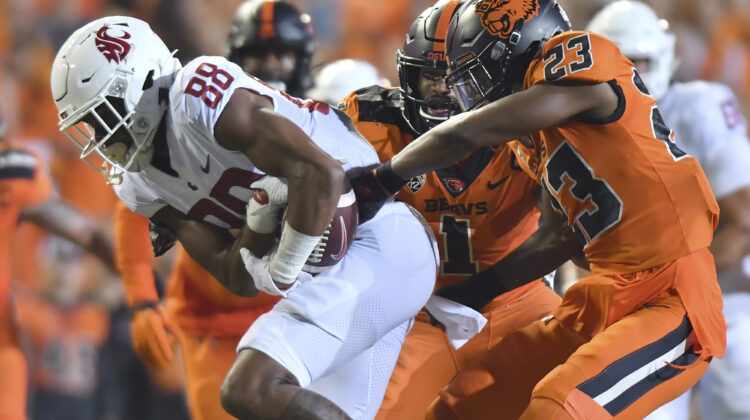It has been 21 weeks since they were completely abandoned, 21 weeks since Oregon State and Washington State became the last two, fighting for survival, revenue and relevance.
On Sept. 1, Stanford and Cal agreed to join the ACC, and the Pac-12 was reduced to a two-team conference starting next summer.
Since being cast adrift, the Beavers and Cougars have played their cards exactly right.
They took the conference and the 10 departing schools to court and won control of the governing board, the rights to the financial assets and help with liabilities.
They entered a football scheduling agreement with the Mountain West.
They did the same with the West Coast Conference for basketball and other sports.
They took the worst poker hand in the history of college sports and did not fold.
“They came out of this in as good of a position as anyone could have imagined,” said an industry source unaffiliated with WSU, OSU or the Pac-12.
But over these five roiling months, there is one thing the Beavers and Cougars did not do: They did not commit, to anything or anyone, beyond the next two seasons.
They are free to monitor the landscape, explore their options and prepare for multiple outcomes.
The NCAA grants a two-year waiver to conferences that have been whacked by realignment, allowing the OSU and WSU football programs to exist under the Pac-12 banner in the 2024-25 seasons.
Starting in the fall of 2026, the Beavers and Cougars must relocate or rebuild.
In the current environment, two-and-a-half years feels like a decade.
By 2026, the ACC or Big 12 might have determined its current structure is suboptimal.
By 2026, athletes might be deemed employees by the National Labor Relations Board.
By 2026, the power conferences might have lost a multi-billion-dollar antitrust lawsuit.
By 2026, the NCAA might have approved president Charlie Baker’s proposal to create a new football subdivision that requires an eight-figure commitment and divides the sport.
By 2026, the structure of major college football could be undergoing a massive transformation — not only a new poker hand but a different poker game.
The moment the Bay Area schools fled to the ACC and locked themselves into a 12-year agreement with a conference in tumult, the Beavers and Cougars took the opposite approach.
They remained as flexible as possible.
The strategy wasn’t merely to prepare themselves for the opportunity to join a new conference (or subdivision) in the second half of the decade.
It was to create a safety net in case The Great Realignment Experiment of 2023 fails and the Pac-12’s outbound schools are forced to reverse course, either in 2026 or soon after.
Specifically, the Beavers and Cougars wanted enough flexibility to offer a landing spot for Stanford and Cal in case the ACC crumbles.
And the ACC just might crumble.
Florida State has taken the conference to court, challenging the grant of rights agreement that is holding everything together.
If the Seminoles leave, they won’t be alone. Clemson, North Carolina and possibly Virginia will flee, as well.
To this point, neither the SEC nor the Big Ten has shown any willingness to accept new members. But that silence is designed to avoid a lawsuit. They can’t make a move on, or utter a peep about, the ACC’s most valuable schools while a contract binds them together.
But if Florida State finds the escape hatch and others follow, then the Big Ten and SEC will swoop in. (North Carolina will be the first pick in the next realignment draft.).
And if Florida State, Clemson, North Carolina and Virginia leave, the ACC would become a carcass.
What then for Stanford and Cal? Do they remain in a conference based on the Atlantic Seaboard that has little media value and second-tier football competition? Or would they return home, join OSU and WSU and rebuild the Pac-12?
That scenario hinges on Florida State’s legal case and the resulting fallout. But even if the Seminoles fail in court, they seem determined to leave, one way or another. And if one goes, others will follow.
At least, that’s the endgame at the heart of the ‘Pac-2’ strategy.
For now, the Beavers and Cougars have more pressing matters:
— They must sign a media rights agreement to broadcast their home football games in 2024 and 2025. We expect that process to conclude in the next few months with exposure, not cash, as the priority. OSU and WSU need to be seen so they are not forgotten.
— They must decide when to fire commissioner George Kliavkoff, whose contract is believed to expire June 30, 2026. To this point, Kliavkoff’s value to the Beavers and Cougars seemingly comes as a presence on the College Football Playoff management committee as the CFP finalizes access and revenue plans for the 2024-25 seasons.
— They must determine the fate of the Pac-12 Networks. The distribution agreements expire this summer, but the infrastructure and studio could exist for years through sale or lease to an entity in need of production support. That could be a media company like Apple or Amazon. Or it could be the outbound Pac-12 schools, who must produce on-campus events for the networks affiliated with their new conferences.
Put another way: The Pac-12 Networks technology will become a huge liability this summer, unless it becomes a valuable asset that generates revenue and helps keep OSU and WSU afloat.
The networks as an asset?
It would be quite the twist to a plot that, for OSU and WSU, has unfolded as smoothly as they could possibly have hoped.
*** Send suggestions, comments and tips (confidentiality guaranteed) to pac12hotline@bayareanewsgroup.
*** Follow me on Twitter: @WilnerHotline
*** Pac-12 Hotline is not endorsed or sponsored by the Pac-12 Conference, and the views expressed herein do not necessarily reflect the views of the Conference.
Related posts:

(AP Photo/Darryl Webb)
Pac-12 survival: What’s next for Oregon State, Washington State, Stanford and Cal after mass exodus to Big Ten, Big 12
Washington State quarterback Cameron Ward (1) (AP Photo/Andy Manis)
Mailbag: WSU and OSU link arms as their playoff path widens, Beavers and Cougars will have a better chance to reach the CFP despite carnage, more Pac-12 chaos: Judge sides with WSU and OSU, brings board business to temporary halt
Pac-12 chaos: Judge sides with WSU and OSU, brings board business to temporary halt

Oregon St. and Washington State (AP Photo/Mark Ylen, File)
Pac-12 survival: Tallying the cash available to Washington State and Oregon State for rebuilding the conference

